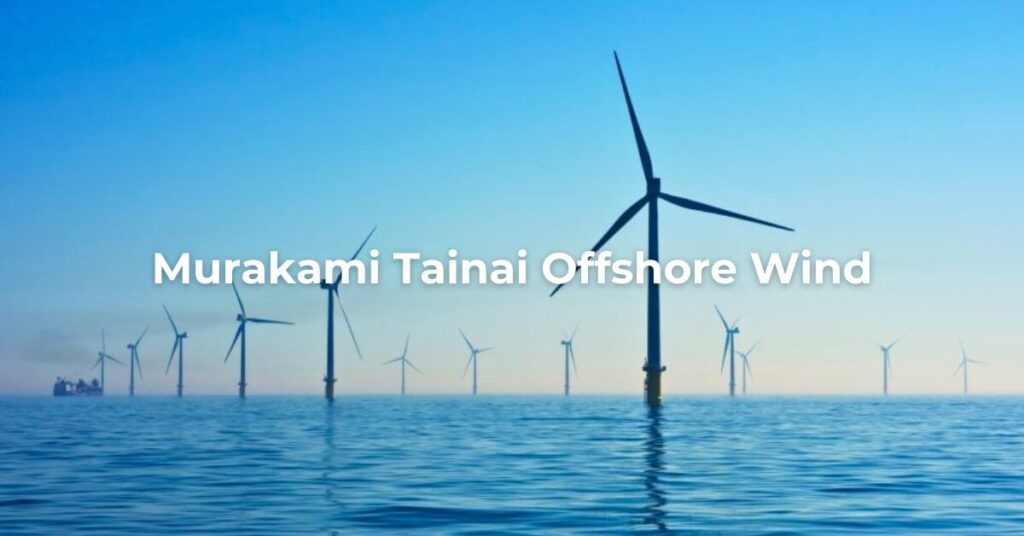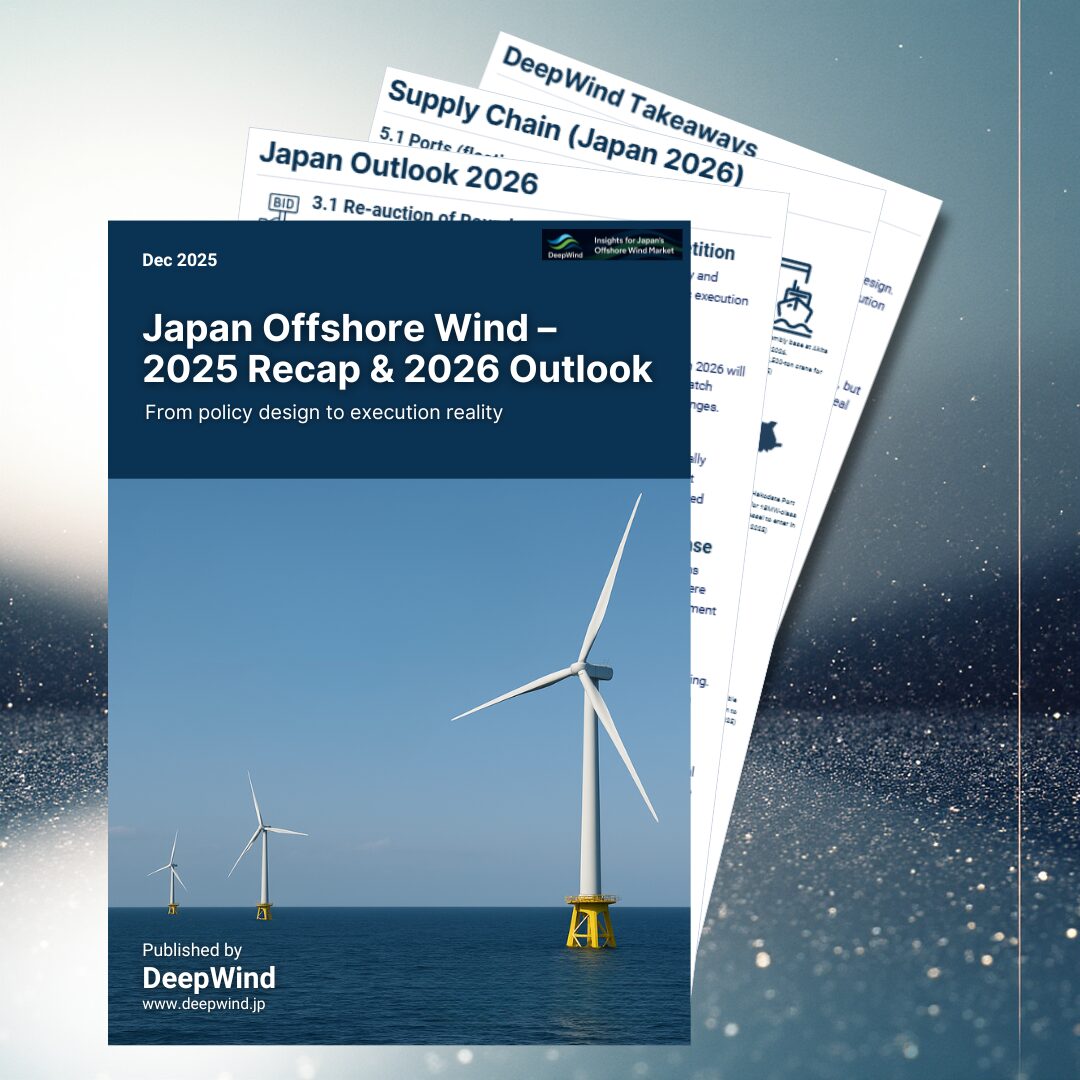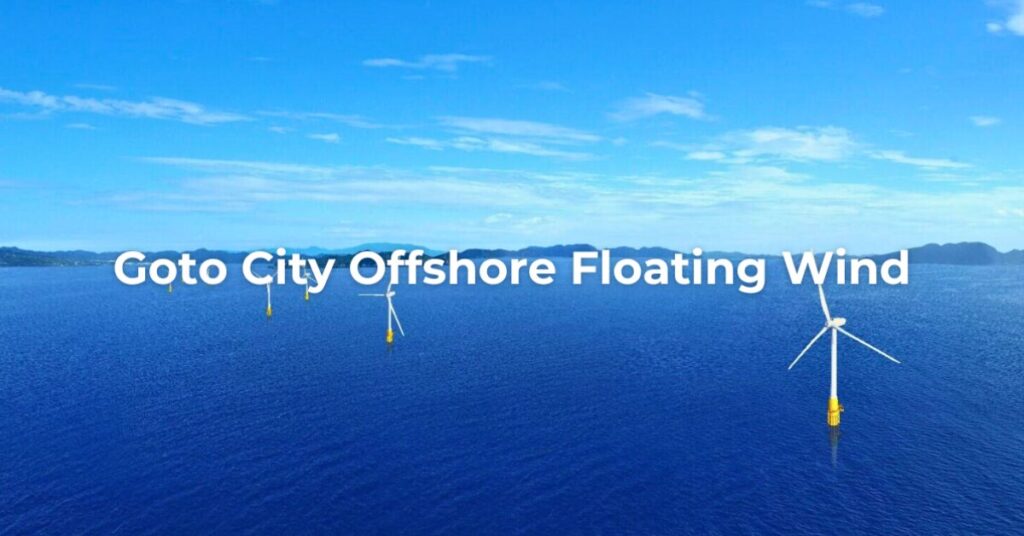Japan is accelerating the deployment of offshore wind power, and one of the most symbolic projects in this effort is the Murakami Tainai Offshore Wind Power Project. This initiative is part of the Japanese government’s second round of offshore wind power auctions—commonly known as “Round 2”—and represents a critical step toward achieving the national targets of 10 GW of offshore wind capacity by 2030 and 30–45 GW by 2040.
With a total planned capacity of 684 MW, the project will significantly contribute to the decarbonization of Japan’s energy mix through fixed-bottom offshore wind power. It is also expected to drive regional industrial development and economic revitalization. This article provides a detailed overview of the project, including its schedule, estimated CAPEX & OPEX and evaluation based on investment viability.
➡ For an overview of all ten Promotion Areas as of 2025, see:
Promotion Areas for Offshore Wind in Japan – 2025 Overview
1. Project Overview
| Project name | Murakami Tainai Offshore Wind |
| Developer | Murakami Tainai Offshore Wind Consortium |
| Consortium Members | Mitsui & Co., Ltd. RWE Offshore Wind Japan Murakami-Tainai K.K. Osaka Gas Co., Ltd. |
| Location | Offshore murakami and tainai City, nigata Prefecture |
| Type | Fixed-bottom Offshore Wind Power |
| WTG | GE |
| Price | 3 JPY/kWh |
| Capacity | 684 MW (18 MW × 38 turbines) |
| Start of Construction | april 2025 → Oct. 2025 |
| Operation Period | june 2029 –2054 |
2. Location
2-1. Sea & Geographical Features
Off the coast of the Sea of Japan in northern Niigata Prefecture. The largest area of the second round, allowing for large-scale development. Blessed with strong winds, but measures must be taken against rough seas and salt damage in winter. Water depth is approximately 30-40m.
2-2. Port Infrastructure & Grid Connection
The utilization and expansion of existing ports such as Niigata Port and Sakata Port is an issue. The power transmission system is planned to be connected to the Tohoku Electric Power area, but due to its large capacity, system expansion (transformation and trunk lines) is required.
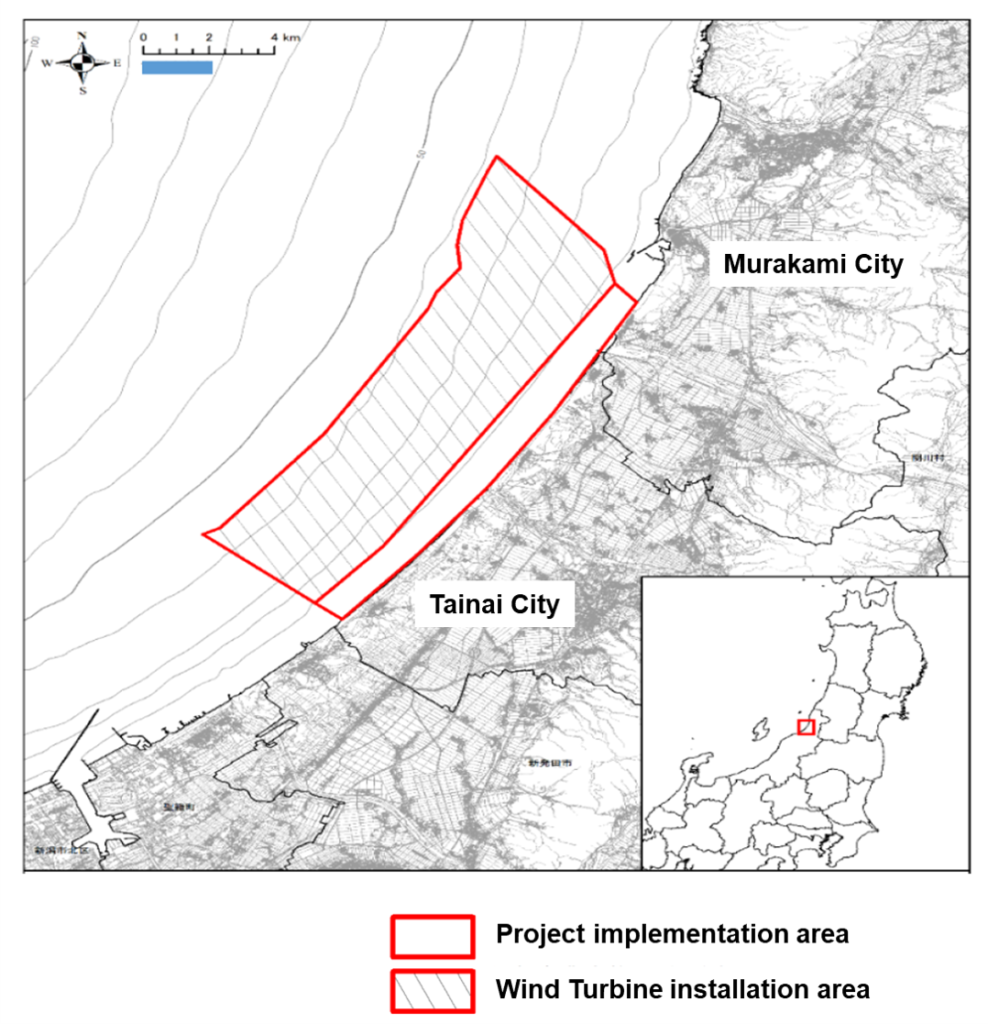
3. Consortium Members
Mitsui & Co., Ltd.
- A general trading company founded in 1876.
- Engaged in a wide range of business sectors, including steel products, mineral and metal resources, energy, infrastructure projects, transportation, food, retail, healthcare, and ICT. Actively investing in renewable energy businesses as well.
RWE
- Started its power generation business in Germany in 1898.
- Holds a total generation capacity of 39.3 GW, including 3.5 GW in offshore wind—ranking second globally in offshore wind capacity.
Osaka Gas Co., Ltd.
- Launched operations in 1905. Supplies city gas to approximately 5 million customers, mainly in the Kansai region (2 prefectures and 5 districts).
- Its core businesses include “Domestic Energy (Gas & Electricity),” “Overseas Energy,” and “Life & Business Solutions.”
- Contributes to a low- and decarbonized society through integrated operations, from renewable energy development to supply (serving 1.71 million low-voltage customers).
4. Project Implementation Structure
4-1. Construction Phase

Source: Public document by the Agency for Natural Resources and Energy, METI
4-2. Operation Phase

Source: Public document by the Agency for Natural Resources and Energy, METI
5. Project Timeline
5-1. Overall schedule
Development & Design Phase (2023–2025)
- December 2023: Award of public auction
- Environmental impact assessment, wind condition, wave, and seabed geological surveys
- Local stakeholder consultations and coordination
- Wind farm certification and submission of construction plan
Construction Phase (2025–2029)
- April 2025 → Oct. 2025: Construction of onshore substation and transmission infrastructure
- June 2027: Installation of offshore foundations and cables
- November 2028: Assembly and installation of wind turbines
Operation & Maintenance Phase (2029–2054)
- Turbine maintenance: GE
- Operation management (BOP): RWE
Decommissioning & Repowering Phase (Post-2054)
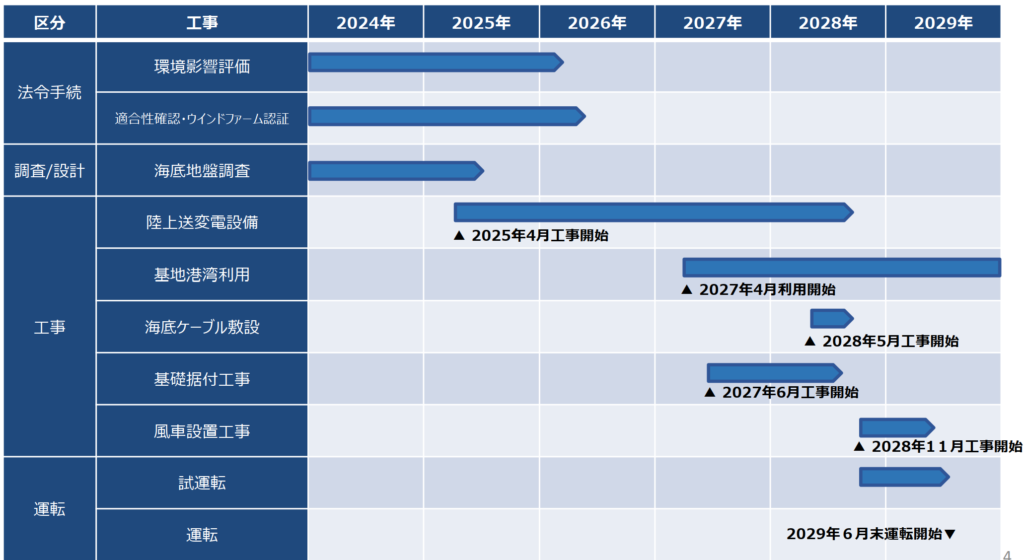
Source: Public document by the Agency for Natural Resources and Energy, METI
5-2. Change in the Start Date of Onshore Construction
On March 28, 2025, the following announcement was made by Murakami City, Niigata Prefecture. Start date of onshore construction date will be changed from April 2025 to around October 2025.
Regarding the start date of onshore construction for the offshore wind power project, Murakami Tainai Offshore Wind Power Co., Ltd., the project operator, has informed us that additional time is required for discussions on selecting the contractor for onshore construction. As a result, the start date will be changed from April 2025 to around October 2025.
Source: Murakami city announcement
5-3. EIA status
| Prefecture | Project name | Developer | EIA Stage | Project Scale | Last updated |
|---|---|---|---|---|---|
| Niigata | (Tentative name) Offshore Wind Power Project off Murakami City and Tainai City | Murakami Tainai Offshore Wind GK | Project Terminated | Total output: up to 600 MW; up to 40 turbines (per-turbine output: 9.5–16 MW) | Jun 3, 2025 |
| Niigata | (Tentative name) Offshore Wind Power Project off Northern Niigata (Murakami City and Tainai City) | Sumitomo Corporation | Project Terminated | Total output: approx. up to 700 MW; per-turbine output: 13–15 MW; up to 53 turbines | Jun 3, 2025 |
| Niigata | (Tentative name) Offshore Wind Power Project off Tainai City and Murakami City, Niigata Prefecture | RWE Renewables Japan GK, Mitsui & Co., Ltd., and Osaka Gas Co., Ltd. | Method Statement | Total output: up to 700 MW; per-turbine output: 13–16 MW; 44–54 turbines | Jan 21, 2025 |
| Niigata | (Tentative name) Offshore Wind Power Project off Murakami City and Tainai City | SSE Pacifico K.K. | Project Terminated | Total output: up to 420 MW; per-turbine output: 14–18 MW class; 28 turbines (for 14 MW each) | May 28, 2024 |
| Niigata | (Tentative name) Offshore Wind Power Project off Murakami City and Tainai City (Sea of Japan) | Invenergy Wind GK | Project Terminated | Total output: up to 700 MW; per-turbine output: approx. 14–17 MW class; up to 50 turbines | May 14, 2024 |
| Niigata | (Tentative name) Offshore Wind Power Project off Murakami City and Tainai City, Niigata Prefecture | Tohoku Electric Power Co., Inc. | Project Terminated | Total output: up to 600 MW; per-turbine output: 12–18 MW; approx. up to 40 turbines | Jan 16, 2024 |
| Niigata | (Tentative name) Offshore Wind Power Project off Murakami City and Tainai City, Niigata Prefecture | Obayashi Corporation | Project Terminated | Total output: up to 700 MW; per-turbine output: 12–18 MW; up to 58 turbines | Nov 7, 2023 |
6. CAPEX & OPEX Estimates
Evaluating the profitability of offshore wind projects requires close attention to cost-related indicators such as CAPEX, OPEX, LCOE, and IRR. However, in Japan’s designated Promotion Zones, publicly available cost data remain scarce, leaving investors and developers with limited information for decision-making.
To address this, we estimated CAPEX, OPEX, LCOE, and IRR using the NEDO cost model, based on representative site conditions including distance to shore, water depth, and distance to port.
👉 Read the full article here
Conclusion
The Murakami Tainai Offshore Wind Power Project is one of the largest and most symbolic projects selected in Japan’s Round 2 offshore wind auctions. With a planned capacity of 684 MW, it will play a critical role in meeting the national targets of 10 GW by 2030 and 30–45 GW by 2040, while also supporting regional economic revitalization.
To explore how this area compares nationally and understand Japan’s offshore wind roadmap, visit:
Promotion Areas for Offshore Wind in Japan – 2025 Overview —
your guide to Japan’s offshore wind Promotion Areas.
Explore more categories at DeepWind:
- 🔍Market Insights – Understand the latest trends and key topics in Japan’s offshore wind market
- 🏛️Policy & Regulations – Explore Japan’s legal frameworks, auction systems, and designated promotion zones.
- 🌊Projects – Get an overview of offshore wind projects across Japan’s coastal regions.
- 🛠️Technology & Innovation – Discover the latest technologies and innovations shaping Japan’s offshore wind sector.
- 💡Cost Analysis – Dive into Japan-specific LCOE insights and offshore wind cost structures.
